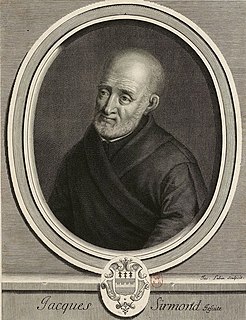
Jacques Sirmond was a French scholar and Jesuit.

Giuseppe Simone Assemani (Classical Syriac : ܝܵܘܣܸܦ ܒܲܪ ܫܸܡܥܘܿܢ, was a librarian, Lebanese Maronite orientalist, and Catholic bishop. For his efforts, and his encyclopedic knowledge, he earned the nickname "The Great Assemani".
Mario Bettinus was an Italian Jesuit philosopher, mathematician and astronomer. The lunar crater Bettinus was named after him by Giovanni Riccioli in 1651.
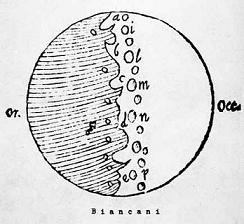
Giuseppe Biancani, SJ (1566–1624) was an Italian Jesuit astronomer, mathematician, and selenographer, after whom the crater Blancanus on the Moon is named. He was a native of Bologna.

Bibliotheca selecta is a bibliographical encyclopedia by the Jesuit Antonio Possevino, printed in two folio volumes at the Typographia Apostolica Vaticana by Domenico Basa in 1593. It represents an authoritative and up-to-date Jesuit compendium of Counter-Reformation knowledge.

Tommaso Fazello was an Italian Dominican friar, historian and antiquarian. He is known as the father of Sicilian history. He is the author of the first printed history of Sicily: De Rebus Siculis Decades Duae, published in Palermo in 1558 in Latin. He was born in Sciacca, Sicily and died in Palermo, Sicily.

Francesco Di Carlo was a member of the Sicilian Mafia who turned state witness in 1996. He was accused of being the killer of Roberto Calvi, nicknamed "God's banker", because he was in charge of Banco Ambrosiano and his close association with the Vatican Bank. He died after contracting COVID-19 during the pandemic on April 16, 2020.

The Archdiocese of Siracusa, also known as Syracuse, is a Latin Church ecclesiastical territory or diocese of the Catholic Church in Sicily. It became an archdiocese in 1844. The current archbishop is Francesco Lomanto.

The Archdiocese of Catania is a Roman Catholic ecclesiastic territory in Sicily, southern Italy, with its seat in Catania. It was elevated to an archdiocese in 1859, and became a metropolitan see in 2000. Its suffragans are the diocese of Acireale and the diocese of Caltagirone.

Leoluca, also Leone Luca, Leo Luke of Corleone, Saint Leoluca, or Luke of Sicily was the abbot and wonderworker of the monastery of Mount Mula in Calabria, and a founder of Italo-Greek monasticism in southern Italy. He is venerated as a saint in the Roman Catholic and Eastern Orthodox churches.
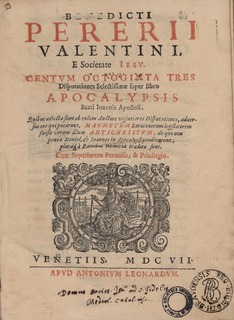
Benedict Pereira was a Spanish Jesuit philosopher, theologian, and exegete.

Gaetano Fichera was an Italian mathematician, working in mathematical analysis, linear elasticity, partial differential equations and several complex variables. He was born in Acireale, and died in Rome.
Aurelio Lippo Brandolini was an Italian humanist and political theorist who briefly flourished in the court of the Hungarian king, Matthias Corvinus. He is the author of the treatise Republics and Kingdoms Compared.

Girolamo Aleandro, the younger was a very distinguished Italian scholar. His grand-uncle Girolamo Aleandro, the elder (1480–1542) is better known and was the first cardinal appointed in pectore.

San Domenico is a Baroque-style Roman Catholic church, located on Piazza San Domenico, and located in the ancient quarter of La Loggia, in central Palermo, region of Sicily, Italy. Piazza San Domenico opens to Via Roma a few blocks south of the large Palazzo delle Poste, and a few blocks north of Sant'Antonio Abate and Teatro Biondo, is the northern border of the warren of alleys of the Vucciria neighborhood. The church houses the burial monuments of many notable Sicilians, and is known thus as the Pantheon of illustrious Sicilians.
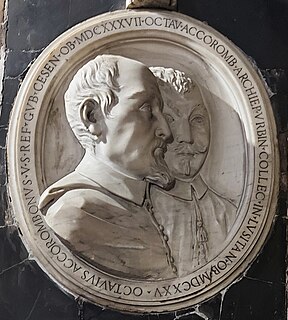
Ottavio Accoramboni was a Roman Catholic prelate who served as Archbishop of Urbino (1621–1623), Apostolic Nuncio to Portugal (1614–1620), and Bishop of Fossombrone (1579–1610).
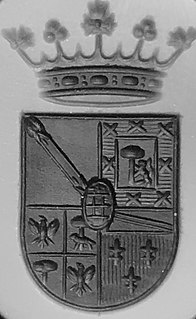
The marquisate of Antella is a noble title given by the king Philip IV of Spain in Sicily to Nicolo Pallavicino Piamonte on septembre 22nd of 1649 due to his support to the Spanish Empire during the Thirty Years War preventing the rebellion of the Neapolitan Republic (1647) and Sicilian rebellion.

The Coronation of Saint Rosalia or Madonna and Child with Saints Rosalia, Peter and Paul is an oil on canvas painting made by Anthony van Dyck in 1629.
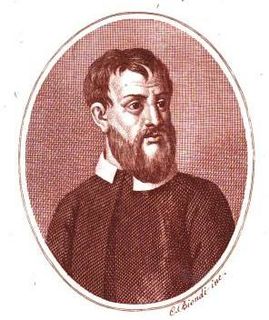
Gian Giacomo Adria or Adria Johannes Jacobus de Paulo was an Italian physician, historian and humanist.
Agostino Inveges (1595-1677) was an Italian historian, known as "the Historian of Palermo". His works include a history of Caccamo entitled La Cartagine siciliana (1651) and his most important work, a three-volume history of Palermo, Annali della felice Città di Palermo (1649-1651). The three volumes cover the period 2077 B.C. to 1279 A.D.
















